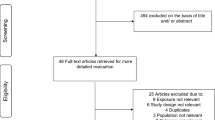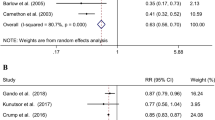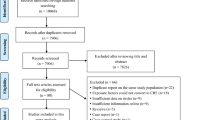Abstract
The dose-response association between cardiorespiratory fitness and risk of atrial fibrillation (AF) is still not well known. Therefore, we performed a comprehensive meta-analysis to investigate the dose-response association between cardiorespiratory fitness and incident AF. We performed a comprehensive search in the databases of PubMed, Cochrane library, and Ovid from inception through August 2019. A one-stage robust error meta-regression method was used to summarize the dose-response association between cardiorespiratory fitness and AF. A total of 9 studies were included in this meta-analysis. In the categorical analysis, compared with the lowest level of cardiorespiratory fitness, both the intermediate (RR = 0.68, 95% CI 0.57–0.82) and highest (RR = 0.60, 95% CI 0.51–0.72) levels of cardiorespiratory fitness were associated with a decreased risk of AF. In the dose-response analysis, per 1 metabolic equivalent increase in cardiorespiratory fitness was associated with a decreased risk of AF (RR = 0.91, 95% CI 0.86–0.95). There was an inverse relationship between cardiorespiratory fitness and risk of AF with evidence of linearity (Pnon-linearity = 0.43). Current evidence suggests that there is an inverse relationship between cardiorespiratory fitness and risk of AF, manifesting as a higher level of cardiorespiratory fitness is associated with a decreased risk of AF.




Similar content being viewed by others
References
Brandes A, Smit MD, Nguyen BO, Rienstra M, Van Gelder IC (2018) Risk factor management in atrial fibrillation. Arrhythm Electrophysiol Rev 7(2):118–127
Kwok CS, Anderson SG, Myint PK, Mamas MA, Loke YK (2014) Physical activity and incidence of atrial fibrillation: a systematic review and meta-analysis. Int J Cardiol 177(2):467–476
Ofman P, Khawaja O, Rahilly-Tierney CR, Peralta A, Hoffmeister P, Reynolds MR, Gaziano JM, Djousse L (2013) Regular physical activity and risk of atrial fibrillation: a systematic review and meta-analysis. Circ Arrhythm Electrophysiol 6(2):252–256
Nielsen J, Wachtell K, Abdulla J (2013) The relationship between physical activity and risk of arial fibrillation-a systematic review and meta-analysis. J Atrial Fibrillation 5:20–27
Zhu W, Wan R, Din Y, Xu Z, Yang X, Hong K (2016) Sex differences in the association between regular physical activity and incident atrial fibrillation: a meta-analysis of 13 prospective studies. Clin Cardiol 39(6):360–367
Al-Mallah MH, Sakr S, Al-Qunaibet A (2018) Cardiorespiratory fitness and cardiovascular disease prevention: an update. Curr Atheroscler Rep 20(1):1
Zhu W, Shen Y, Zhou Q, Xu Z, Huang L, Chen Q, Hong K (2016) Association of physical fitness with the risk of atrial fibrillation: a systematic review and meta-analysis. Clin Cardiol 39(7):421–428
Alonso A, Bahnson JL, Gaussoin SA, Bertoni AG, Johnson KC, Lewis CE, Vetter M, Mantzoros CS, Jeffery RW, Soliman EZ (2015) Effect of an intensive lifestyle intervention on atrial fibrillation risk in individuals with type 2 diabetes: the Look AHEAD randomized trial. Am Heart J 170(4):770–777
Pathak RK, Elliott A, Middeldorp ME, Meredith M, Mehta AB, Mahajan R, Hendriks JM, Twomey D, Kalman JM, Abhayaratna WP, Lau DH, Sanders P (2015) Impact of CARDIOrespiratory FITness on arrhythmia recurrence in obese individuals with atrial fibrillation: the CARDIO-FIT study. J Am Coll Cardiol 66(9):985–996
Moher D, Liberati A, Tetzlaff J, Altman DG (2009) Preferred reporting items for systematic reviews and meta-analyses: the PRISMA statement. PLoS Med 6(7):e1000097
Wells GA, Shea B, O'Connell D, Peterson J, Welch V, Losos M, Tugwell P (2014). The Newcastle Ottawa Scale (NOS) for assessing the quality of nonrandomized studies in meta-analyses. Available at: http://www.ohri.ca/programs/clinical_epidemiology/oxford.asp. Accessed August 10, 2019.
Zhu W, Wan R, Liu F, Hu J, Huang L, Li J, Hong K (2016) Relation of body mass index with adverse outcomes among patients with atrial fibrillation: a meta-analysis and systematic review. J Am Heart Assoc 5(9):e4006
Greenland S, Longnecker MP (1992) Methods for trend estimation from summarized dose-response data, with applications to meta-analysis. Am J Epidemiol 135(11):1301–1309
Xu C, Doi S (2018) The robust error meta-regression method for dose-response meta-analysis. Int J Evid Based Healthc 16(3):138–144
Liu X, Guo N, Zhu W, Zhou Q, Liu M, Chen C, Yuan P, Wan R, Hong K (2019) Resting heart rate and the risk of atrial fibrillation. Int Heart J 60(4):805–811
Qureshi WT, Alirhayim Z, Blaha MJ, Juraschek SP, Keteyian SJ, Brawner CA, Al-Mallah MH (2015) Cardiorespiratory fitness and risk of incident atrial fibrillation: results from the Henry Ford Exercise Testing (FIT) project. Circulation 131(21):1827–1834
Khan H, Kella D, Rauramaa R, Savonen K, Lloyd MS, Laukkanen JA (2015) Cardiorespiratory fitness and atrial fibrillation: a population-based follow-up study. Heart Rhythm 12(7):1424–1430
Pittaras A, Faselis C, Doumas M, Manolis AJ, Grassos H, Kifnidis K, Kouremenos N, Papavasileiou M, Kallistratos M, Athanasiadis I, Kokkinos P (2015) 5A.02: fitness status and risk for atrial fibrillation. J Hypertens 33(Suppl 1):e64
Garnvik LE, Malmo V, Janszky I, Wisløff U, Loennechen JP, Nes BM (2019) Estimated cardiorespiratory fitness and risk of atrial fibrillation. Med Sci Sports Exerc 1. https://doi.org/10.1249/MSS.0000000000002074
Tikkanen E, Gustafsson S, Ingelsson E (2018) Associations of fitness, physical activity, strength, and genetic risk with cardiovascular disease: longitudinal analyses in the UK Biobank study. Circulation 137(24):2583–2591
Faselis C, Kokkinos P, Tsimploulis A, Pittaras A, Myers J, Lavie CJ, Kyritsi F, Lovic D, Karasik P, Moore H (2016) Exercise capacity and atrial fibrillation risk in veterans: a cohort study. Mayo Clin Proc 91(5):558–566
Steell L, Ho FK, Sillars A, Petermann-Rocha F, Li H, Lyall DM, Iliodromiti S, Welsh P, Anderson J, MacKay DF, Pell JP, Sattar N, Gill JM, Gray SR, Celis-Morales CA (2019) Dose-response associations of cardiorespiratory fitness with all-cause mortality and incidence and mortality of cancer and cardiovascular and respiratory diseases: the UK Biobank cohort study. Br J Sports Med 53(21):1371–1378. https://doi.org/10.1136/bjsports-2018-99093
Bose A, O’Neal WT, Bennett A, Judd SE, Qureshi WT, Sui X, Howard VJ, Howard G, Soliman EZ (2017) Relation between estimated cardiorespiratory fitness and atrial fibrillation (from the Reasons for Geographic and Racial Differences in Stroke Study). Am J Cardiol 119(11):1776–1780
Crump C, Sundquist J, Winkleby MA, Sundquist K (2018) Height, weight, and aerobic fitness level in relation to the risk of atrial fibrillation. Am J Epidemiol 187(3):417–426
Morseth B, Lochen ML, Ariansen I, Myrstad M, Thelle DS (2018) The ambiguity of physical activity, exercise and atrial fibrillation. Eur J Prev Cardiol 25(6):624–636
Andersen K, Rasmussen F, Held C, Neovius M, Tynelius P, Sundstrom J (2015) Exercise capacity and muscle strength and risk of vascular disease and arrhythmia in 1.1 million young Swedish men: cohort study. BMJ 351:h4543
Hussain N, Gersh BJ, Gonzalez CK, Sydo N, Lopez-Jimenez F, Kopecky SL, Thomas RJ, Asirvatham SJ, Allison TG (2018) Impact of cardiorespiratory fitness on frequency of atrial fibrillation, stroke, and all-cause mortality. Am J Cardiol 121(1):41–49
Khan H, Kunutsor SK, Rauramaa R, Merchant FM, Laukkanen JA (2018) Long-term change in cardiorespiratory fitness in relation to atrial fibrillation and heart failure (from the Kuopio Ischemic Heart Disease Risk Factor Study). Am J Cardiol 121(8):956–960
Contributors
ZB-X, Y-Z, and WG-Z performed the literature search, study selection and data extraction, quality assessment, and statistical analysis. CY-W, J-L, and X-L help check the data to ensure accuracy. ZB-X and Y-Z wrote the original draft, while WG-Z revised the draft. P-Y edited the manuscript prior to submission to ensure the standard English grammar.
Author information
Authors and Affiliations
Corresponding author
Ethics declarations
Conflict of interest
The authors declare that they have no conflict of interest.
Ethical approval
Not required.
Additional information
Publisher’s note
Springer Nature remains neutral with regard to jurisdictional claims in published maps and institutional affiliations.
Zhengbiao Xue and Yue Zhou are co-first authors.
Electronic supplementary material
ESM 1
(DOCX 163 kb).
Rights and permissions
About this article
Cite this article
Xue, Z., Zhou, Y., Wu, C. et al. Dose-response relationship of cardiorespiratory fitness with incident atrial fibrillation. Heart Fail Rev 25, 419–425 (2020). https://doi.org/10.1007/s10741-019-09871-5
Published:
Issue Date:
DOI: https://doi.org/10.1007/s10741-019-09871-5




